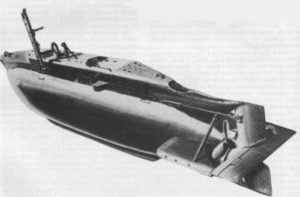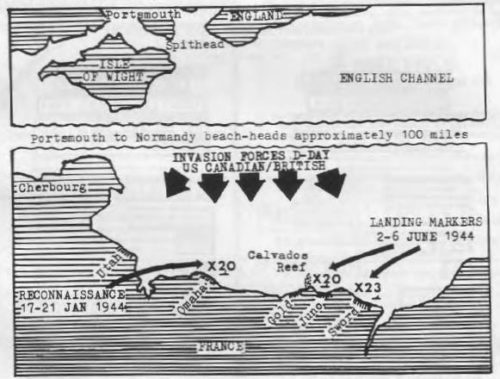- Author
- Hudspeth, K.R., LCDR, RANR Rtd
- Subjects
- WWII operations
- Tags
-
- RAN Ships
- None noted.
- Publication
- September 1994 edition of the Naval Historical Review (all rights reserved)
In September 1943, six X-Craft left Britain in Operation Source, aiming to attack the German battleship TIRPITZ and other capital ships in Altenfjord, some 1,000 miles away in Arctic Norway. TIRPITZ was crippled, but no X-Craft returned. X10, which I commanded, suffered serious defects and we failed to attack. Under tow on return, with prospects of bad weather, she was scuttled under orders from Admiralty. These craft were X5-X10, all built by Vickers-Armstrong.
After debriefing and leave X10’s crew was appointed to stand by and commission X20, first of another group of six identical boats. These were being constructed in pairs by engineering firms in inland cities in the north of England. X20 came from Thomas Broadbent & Son, of Huddersfield. After our disappointment in Altenfjord we were hoping for another offensive operation, the sooner the better. But it was not to be.

Strangers appeared at the Scottish base, from both navy and army, members of one of the teams from an organisation named, ambiguously, Combined Operations Pilotage Parties (COPP). They were led by LCDR Nigel Willmott, RN, an expert navigator (in fact, I think a hydrographer or surveyor).
Given responsibility for navigating raiding groups ashore in the Mediterranean he quickly became aware of the inadequate and inaccurate– information available about enemy shores, both above and below watermark. He persuaded Combined Ops HQ to let him organise teams to carry out inshore reconnaissance and to act as expert guides to invading forces. Offshore observation was achieved from aircraft and submarine periscopes, but essential inshore information was sought by commando-trained swimmers or canoeists landed from submarines or fast motor boats.
Following valuable operations in the Mediterranean, COPPs were faced with the need for close examination of the Normandy coast as part of the preparation for the planned invasion of Europe in the summer of 1944. The waters were too shallow for large submarines and motor boats could only do quick overnight dashes.
X-Craft offered a possibility, hence the visit to Loch Striven. We were deputed to initiate the visitors into the mysteries of small submarine operation, and to take them on exercise expeditions to test the practicability of using our craft in the English Channel. The COPPs found the experience thoroughly unpleasant, but they were no strangers to discomfort and the decision was made to employ them.
As a result, in mid December 1943, X20 was railed to Portsmouth to be based in the principal RN Submarine base, HMS DOLPHIN. X23 (Lieut George Honour, RNVR) was to follow later. The COPP 1 team, led by Willmott himself, was allocated to work from X20, COPP 9 from X23.
The initial Combined Ops intention was for a short sortie in the dark period at New Years Eve and X20 was in full readiness. However, at the last minute very senior officers feared the risk of discovery and compromise and the reconnaissance team crossed instead by small surface craft and in atrocious weather secured vital information on the shores inside the Calvados Reef.
The intention and the hope were for a series of X-Craft expeditions, and we carried out extensive exercises in the shallow waters of the Solent. Meanwhile, to meet COPP requirements additions and modifications were made by Portsmouth dockyard and DOLPHIN. Extra buoyancy was provided by cylinders welded on either side, to compensate for the extra COPP bodies and their gear. An anchor was stowed in the casing, taut-wire measuring gear and a gyro-repeater mounted on deck, an echo-sounder was installed and a long sounding-pole secured to the casing.

Operation Postage Able – Jan 17-21, 1944
As it turned out only one X-Craft reconnaissance operation was undertaken, using X20. The “Able” in the title indicated that others were anticipated, but in spite of highly satisfactory results high command decided not to risk further attempts.
Only two X-Craft officers were aboard, responsible for operation of the craft. Willmott was in charge, virtually as a flag-officer and two army members of COPP (Major Scott-Bowden and Sergeant Ogden-Smith) were to do the shore exploration besides sharing steering and depth-keeping.




